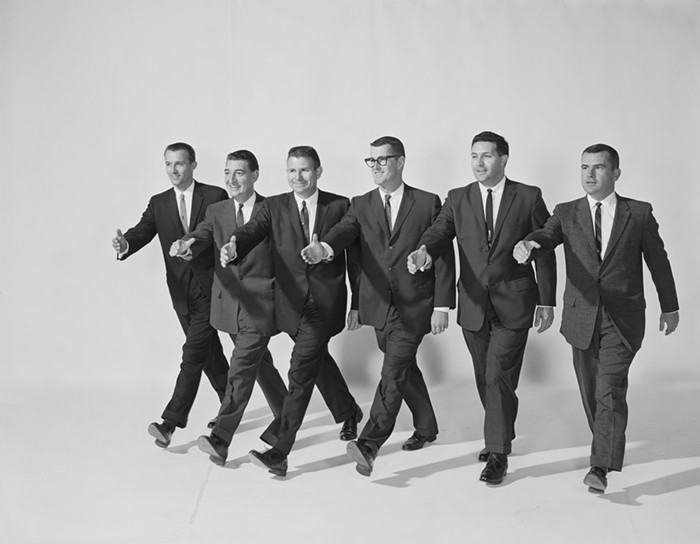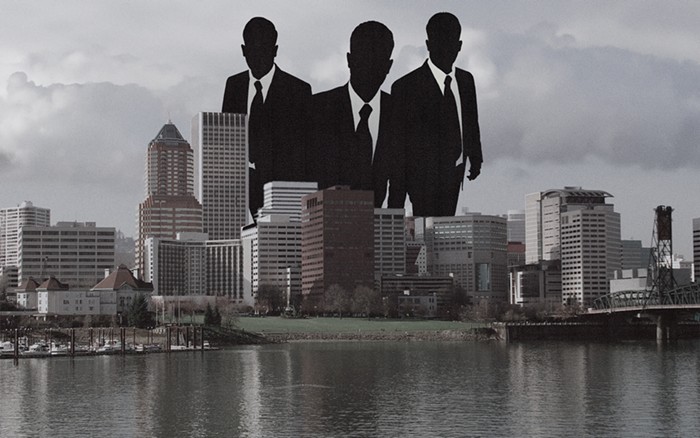Oregon Ballet Theatre’s spring program, which opened last Friday at the Newmark Theatre, reminded me why they’re one of the region’s most worthy arts organizations. The programming was risky and inventive, the performances were fully committed, and the quality of artistry never fell below a certain high standard of excellence.
Occasionally it rose even higher: much higher, in two instances. The first was in William Forsythe’s punishing mad sprint of a dance, “The Vertiginous Thrill of Exactitude,” which OBT first performed two years ago. Three women, with bright green discs as tutus, and two men in rust tights are sent across the stage in varying solos and ensemble couplings, always at breakneck tempo (the music, recorded, is the “allegro vicace” movement of Schubert’s Symphony no. 9 in C Major). There are liquid arms and stuttering angular legs; the dance, like the symphony, is packed both with singing musical lines and punchy jabs and jaunts. By the work's end, all five dancers are drenched in sweat (the men especially).
The dizzying entirety of it can start to seem almost mathematical, but it’s just then that the calculations are interrupted by some whimsical movement — a diminutive pastoral leap, or quirky off-kilter trio. In fact, Forsythe’s dance is so loaded with movement and meaning that, like all great works of art, it bears repeated viewings. The quintet of OBT company members did well by it, with principal dancer Kathi Martuza alone suggesting the joy of exactitude might also be part of the thrill.
The unquestionable program hit was Brooklyn-born choreographer Nicolo Fonte’s “Left Unsaid,” a sextet set to solo violin sonatas and partitas by J.S. Bach, receiving its company premiere. If there’s a recent new work that has elicited more audible gasps and intermission chatter from OBT audiences than this, I haven’t seen it.
The magic of Fonte’s extraordinary creation comes from the way he manipulates small movements — a female dancer (Anne Mueller, in an exquisite, emotionally shaded performance) crawls invitingly across the laps of three men, and suddenly she’s laid out flat, stiff as a corpse — to explore elemental, gut emotions on the continuum from birth to death. Fonte’s work also exposes the raw sensuousness of Bach’s solo violin works (played on recording by the fabulous Lara St. John), and the dance is tense with coiled sexuality, human fragility and simply moving encounters between men and women onstage.
It’s all the more impressive that Fonte has created such an arresting work with only the barest of essentials: a stage, six dancers, a few chairs, and strong lighting design. All of the aesthetic components of “Left Unsaid” come together strikingly, from the evocative lighting by Michael Mazzola, to the sky blue dresses for the women and the hip dark Gucci suits for the men. This was a moment of glory for the six accomplished OBT dancers featured in the work, and they all deserve due credit: Daniela Deloe, Yuka Iino, Anne Mueller, Brian Simcoe, Artur Sultanov and especially Steven Houser, who continues to grow as a young member of the company on the ascendant.
Before moving to the evening’s world premiere, there was a brief stop in Balanchine-land, by way of the master’s “Tarantella,” a tambourine-flecked confection danced with confidence by Ansa Deguchi and Chauncey Parsons, who leaps through the air with a constant look of surprise on his face.
Dancemaker James Kudelka has enjoyed an especially close relationship with OBT during artistic director Christopher Stowell’s tenure at the company, and his “Almost Mozart” (2006) has become a company staple. On commission from OBT, Kudelka has come up with a sort of Pagan-influenced meditation piece, “Hush,” set to an airy score for both traditional and celtic harp by Rodney Sharman, and played live (Rita Costanzi, pedal harpist; Auna Selberg, celtic harpist).
The work’s poignant opening moment promised extraordinary simplicity and grace, as company artist Javier Ubell opened and closed his heart again and again, then laid down in what I imagined was a grassy hillside. A quartet of young women entered, arms linked, to rouse the boy - a touching scene. Soon after, another male company artist, Ian Buchanan, ran on to execute a series of searching circles, punctuated with those traveling young ladies.
The dance went on like this at some length: elegant pas de deux (a nod to the lovely Gavin Larsen and Chauncey Parsons, who mugged less here), small ensemble work and an especially trance-like movement for the male corps, always set to those tinkling harps upstage, and always featuring Kudelka’s easy-to-watch modern classical ballet vocabulary, stripped to its essentials.
But by the time we reached the work’s halfway point, the understated elegance had lapsed into a sort of dull boredom, and the movement too often looked like it was vamping on an endless loop. The work likely would have been twice as effective at half the length, and Kudelka doesn’t come close to earning the finale he’s devised, which comes out of nowhere.
The audience sensed this, too; their tepid opening night response to "Hush" is probably one of those things better left unsaid.
(OBT's spring program, "Left Unsaid," continues through April 26 at the Newmark Theatre. Tickets available online here)












